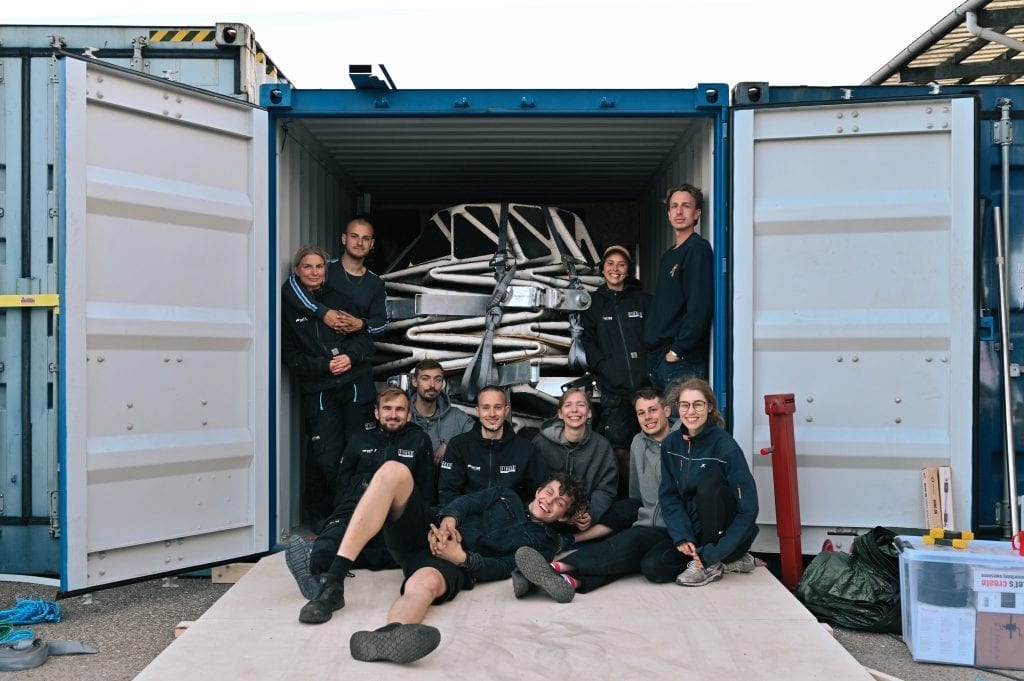Be careful of Huel-hungry arctic foxes, don’t put anything important on the ground in the snow if you ever want to see it again, and a tidy habitat makes for a tidy mind. This is a snapshot of advice from Sebastian and Karl-Johan, who are now over two months into their arctic moon-mission.
If you didn’t catch our last article, Sebastian Aristotelis and Karl-Johan Sørensen are two Danish architects who, in early October, set up camp on the outskirts of the abandoned settlement of Moriusaq in the arctic north of Greenland. Their objective? To prove that their lunar habitat, one and a half years in the making, had the potential to house humans on the moon.
At this point of the mission, Sebastian and Karl-Johan have been in the habitat for 54 days. For a behind-the-scenes look at the team’s progress, we caught up with Simon Kristensen, Lunark CTO and essentially the team’s “Houston” during the mission, who talked to us from Lunark’s base in Copenhagen.

Troubleshooting Over Satellite Phone
As their technical and troubleshooting expert, Simon is on call 24/7 to support the pair if there is a pressing need for support during the mission. Simon’s role is crucial to the team. As CTO, he has the most detailed knowledge of the habitat’s central brain, “Odin”, the Lenovo ThinkCentre M90n Nano IoT hub. Odin, named after the god of Norse mythology, collects and processes data from the 76 sensors dotted around the habitat, which the team call its ‘ravens,’ in accordance with the mythical birds who gather intelligence for Odin. In much the same way, the system gives Sebastian and Karl-Johan the information they need to keep the habitat running and ultimately enable them to survive the harsh conditions.
Although the habitat is now up and running, there are plenty of day-to-day activities the two must complete to maintain their arctic home. To keep the lights on they need to refuel the generator, and they must regularly check the habitat for any damage, especially after heavy storms. Thankfully, if there are any breakages, or irregularities, Odin sends them a notification to investigate further.
When they make these outdoor excursions, the pair are wrapped up in bespoke helicopter suits, modified with electrical heating technology that enables them to weather freezing temperatures that will plummet to near to -30 C. To bring them as close as possible to a real moon mission, they have 3D Printed Helmets to simulate the full experience.

As well as work on the habitat, the Lunark team’s days are filled with research and tasks set by the host of research teams they are working with, to provide them with the scientific results needed to further the study of life in space.
Life in the Habitat
So, what has life been like for the pair now they’re in the safe confines of the habitat? While Simon’s calls with the team are mostly focused on troubleshooting any issues that arise with the habitat, due to the limited nature of the communication, which is limited to 140 characters for each transmission, the pair’s updates on the website paint a picture of their life in the habitat.

Simon explains that they have a mix of downtime, when they’re encouraged to be introspective and entertain themselves with the entertainment and games loaded on their ThinkPad P53 Laptops, which are the only visual window they have to the world back home.
Outside, the days have rapidly grown shorter for the pair as daylight hours dwindle down to zero. As of October 29 the pair had six hours of ‘daylight,’ but this has now fallen to zero for the final stretch of the mission. To support their circadian rhythms Odin luminates the habitat gradually throughout the day.

As they move into the final stretch of the mission, the pair will need to stave off the “third quarter phenomenon,” which is a drop in morale nearing the end of a mission that is documented by psychologists who have studied astronauts throughout their missions in space. To combat this, the pair will be looking forward to the care packages they brought with them, which they’re under strict instruction to open at specific days of the mission. Simon assured us that his care package would cater well to their needs, filled with chocolate, beef jerky and a bottle of vodka.
As a testament to the close-knit nature of the Lunark team, it’s worth noting that Simon is sporting some great facial hair, which he explains has a link to the mission. Apparently, the clean-shaven look Sebastian was sporting when we spoke to him back in October was intentional for the mission. Simon did the same before the pair left Copenhagen and plans to let the beard and hair grow out until they’re back home as a sign of his solidarity with the pair.
In our next instalment of the Lunark story, we are excited to bring you a post-mission interview with Karl-Johan and Sebastian on their return from Greenland. Simon couldn’t verify whether the pair had taken razors with them to the arctic, so we may well also have some impressive post-mission hair, à la Tom Hanks in Castaway. Stay tuned!
